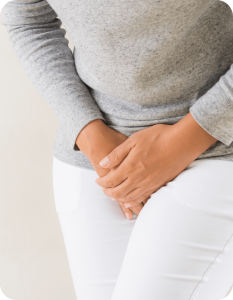Urinary Incontinence
Urinary incontinence is a sign of pelvic floor dysfunction and can cause physical and emotional distress among people as it removes a person’s bladder control. Dr Kelly Hankins offers a variety of treatment options for people experiencing urinary incontinence.
What is Urinary Incontinence?
Urinary incontinence is the involuntary leakage of urine, a condition that affects millions of people worldwide. It can vary from occasional minor leaks to a more frequent and severe loss of bladder control. While it can affect anyone, it is more common in older adults, particularly women.

Causes of Incontinence
Urinary incontinence can result from a variety of causes. Understanding these can help in diagnosing and managing the condition effectively.
- Pregnancy and Childbirth: During pregnancy, the growing uterus puts pressure on the bladder, which can lead to stress incontinence. Additionally, childbirth can weaken the pelvic floor muscles and damage the nerves controlling the bladder, leading to both stress and urge incontinence.
- Ageing and Menopause: As people age, the muscles of the bladder and urethra can weaken, reducing the ability to control urination. In women, menopause leads to a decrease in oestrogen, which can weaken the tissues of the bladder and urethra, contributing to incontinence.
- Family History: A family history of urinary incontinence can increase the risk of developing the condition. Genetic factors may influence the structure and function of the urinary tract and pelvic floor muscles.
- Pelvic Organ Prolapse: Pelvic organ prolapse occurs when the pelvic organs, such as the bladder, uterus, or rectum, drop from their normal position and press against the vaginal walls. This can interfere with bladder function and lead to incontinence.
- Urinary Tract Infections (UTIs): UTIs can irritate the bladder and cause a strong, sudden urge to urinate, leading to urge incontinence. The infection can also increase the frequency of urination and cause discomfort.
- Neurological Disorders: Neurological disorders, such as multiple sclerosis, Parkinson’s disease, stroke, and spinal cord injuries, can disrupt the nerve signals involved in bladder control, leading to various types of incontinence.
Symptoms of Urinary Incontinence
The primary symptom of urinary incontinence is the unintentional release of urine. However, the nature of the symptoms can vary based on the type of incontinence.
Symptoms include:
- A sudden, intense urge to urinate followed by involuntary leakage
- Frequent urination, including waking up multiple times at night to urinate
- Dribbling urine after finishing urination
- Inability to reach the bathroom in time
- Leakage when laughing, coughing, sneezing, or during physical activity
- Needing to strain when urinating
- Having a weak stream when urinating
- Experiencing sudden ‘accidents’ during the day or while sleeping
- Feeling as though your bladder is never empty
Types of Urinary Incontinence
Understanding the type of urinary incontinence is important for effective treatment. The main types include:
Stress incontinence occurs when physical movement or activity, such as coughing, sneezing, running, or heavy lifting, puts pressure on the bladder, causing urine to leak. This type of incontinence is often due to weakened pelvic floor muscles or urethral sphincter.
Urge incontinence, also known as overactive bladder, is characterised by a sudden, intense urge to urinate, followed by involuntary urine leakage. This occurs when the bladder muscles contract uncontrollably.
Overflow incontinence happens when the bladder doesn’t empty, leading to frequent dribbling of urine. It can occur due to a blockage or weak bladder muscles.
Functional incontinence is the inability to reach the bathroom in time due to physical or mental impairments. The urinary system may function normally, but other factors prevent timely bathroom access.
Faecal incontinence, also known as bowel incontinence, is the inability to control bowel movements, leading to the accidental leakage of stool. It can range from occasional leakage to a complete loss of bowel control.
Mixed incontinence involves symptoms of more than one type of incontinence, usually stress and urge incontinence. Patients may experience leakage during physical activity as well as sudden, intense urges to urinate.
Treatment and Management of Urinary Incontinence
Treatment options and management strategies for urinary incontinence depend on the type, severity, and underlying cause of the condition. They include:
Non-Surgical Treatment Options
- Behavioural Techniques: Bladder training (delaying urination to extend the time between bathroom trips), double voiding (urinating, then waiting a few minutes before trying again to empty the bladder more completely), and going to the bathroom at regular, scheduled intervals (even if you do not feel the urge to urinate).
- Pelvic Floor Exercises: Also known as Kegels, these exercises can help strengthen the pelvic floor muscles.
- Lifestyle Changes: Reducing body weight to alleviate pressure on the bladder, limiting caffeine, alcohol, and acidic foods that can irritate the bladder, and monitoring and managing fluid intake.
- Medications: Certain prescribed medications can help calm an overactive bladder, relax the bladder muscle to allow more urine storage, relax the bladder neck muscles in men with prostate issues, and strengthen the tissues around the urethra for postmenopausal women.
- Medical Devices: A pessary is a device inserted into the vagina to support the bladder, and a urethral insert is a tampon-like device inserted into the urethra before incontinence-causing activities.
Interventional Therapies
- Nerve Stimulators: Devices implanted to stimulate nerves controlling the bladder.
- Dr Hankins works closely with sub-specialists who can assist with treating urinary incontinence when needed.
Surgical Treatment Options
- Slings: Creating a hammock-like support for the urethra or bladder neck to keep it closed.
- Bladder Neck Suspension: Lifting and securing tissues around the bladder neck to provide support to the bladder neck and urethra.
- Pelvic Floor Repair: Repairing pelvic organ prolapse (a condition that can contribute to incontinence) by reattaching prolapsed organs to pelvic muscles.
Urinary incontinence is a common issue that can significantly impact the quality of life, but many effective treatments are available. If you’re suffering from urinary incontinence, schedule a consultation with Dr Kelly Hankins who can provide guidance and a tailored treatment plan to support your pelvic health needs.